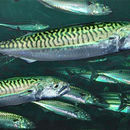Biology
provided by Arkive
Adult Atlantic mackerels form schools close to the surface; they have to swim constantly as they 'breathe' by a method known as ram ventilation, which requires a constant flow of water across the gill surfaces (5).
They are active mainly in the day (2), and feed on small fishes such as sand eels (Ammodytes spp.), as well as small crustaceans, which are filtered from the water (4). They spend the winter in deep water, and stop feeding at this time (4); they migrate closer to shore during spring (2).
During spawning, eggs and sperm are released into the sea. Both the eggs and larvae are pelagic; the eggs have a globule of oil, which keeps them afloat in the surface waters (4). Larvae begin to feed on copepods (tiny crustaceans) when they reach sizes of around 3mm. They will have grown to lengths of 25 cm after just one year. This is a long-lived species; the maximum recorded lifespan in the North Sea is 25 years (4).
Conservation
provided by Arkive
In Europe, the European Union is responsible for conserving and managing marine fish and their fisheries, with fisheries controlled by the Common Fisheries Policy (CFP) (6). However, in the past the CFP has not effectively controlled the fishing fleets of the EU; furthermore there are complex socio-economic issues involved in this controversial issue, with entire communities wholly dependent on the fishing industry (6). The International Council for the Exploration of the Seas (ICES) advises governments on the status of fish stocks, yet often their warnings have gone unheeded (7). The British Government has limited powers to initiate marine fisheries management measures. However, a grouped Action Plan for commercial marine fish has been produced under the UK Biodiversity Action Plan. This aims to minimise the collapse of local stocks of a number of commercially exploited marine fish (6).
Description
provided by Arkive
The Atlantic mackerel is a beautifully streamlined, fast-swimming fish. It has silver underparts and metallic green and blue upperparts with irregular bands along the back (3). It belongs to the same family as tuna (4), and is a highly commercial species (2).
Habitat
provided by Arkive
This pelagic fish lives in the open ocean (2).
Range
provided by Arkive
Inhabits the north Atlantic Ocean, as well as the Baltic, Mediterranean and Black Seas. Along the coast of North America it is found from Labrador to Cape Lookout. There are two main stocks in the north-east Atlantic, the North Sea (east) and British Isles (west) (2).
Status
provided by Arkive
Widespread and common, but facing severe fishing pressure (6).
Threats
provided by Arkive
The North Sea and British Isles stocks of Atlantic mackerel declined drastically during the 1960's as a result of overfishing (2). Indeed, like many commercial marine fishes, the Atlantic mackerel faces severe pressure from fishing throughout its wide range (6). The overfishing of stocks of commercial fish is a severe and complex problem around the world, with many well-known species including cod and plaice in serious decline and at risk of complete collapse (7). As the technology involved in fishing has improved and the number of faster, more efficient boats has increased, populations of fish have decreased further and have been unable to reproduce fast enough to compensate for the massive losses (7). The problem can be summed up as: 'too many boats chasing too few fish' (6).

